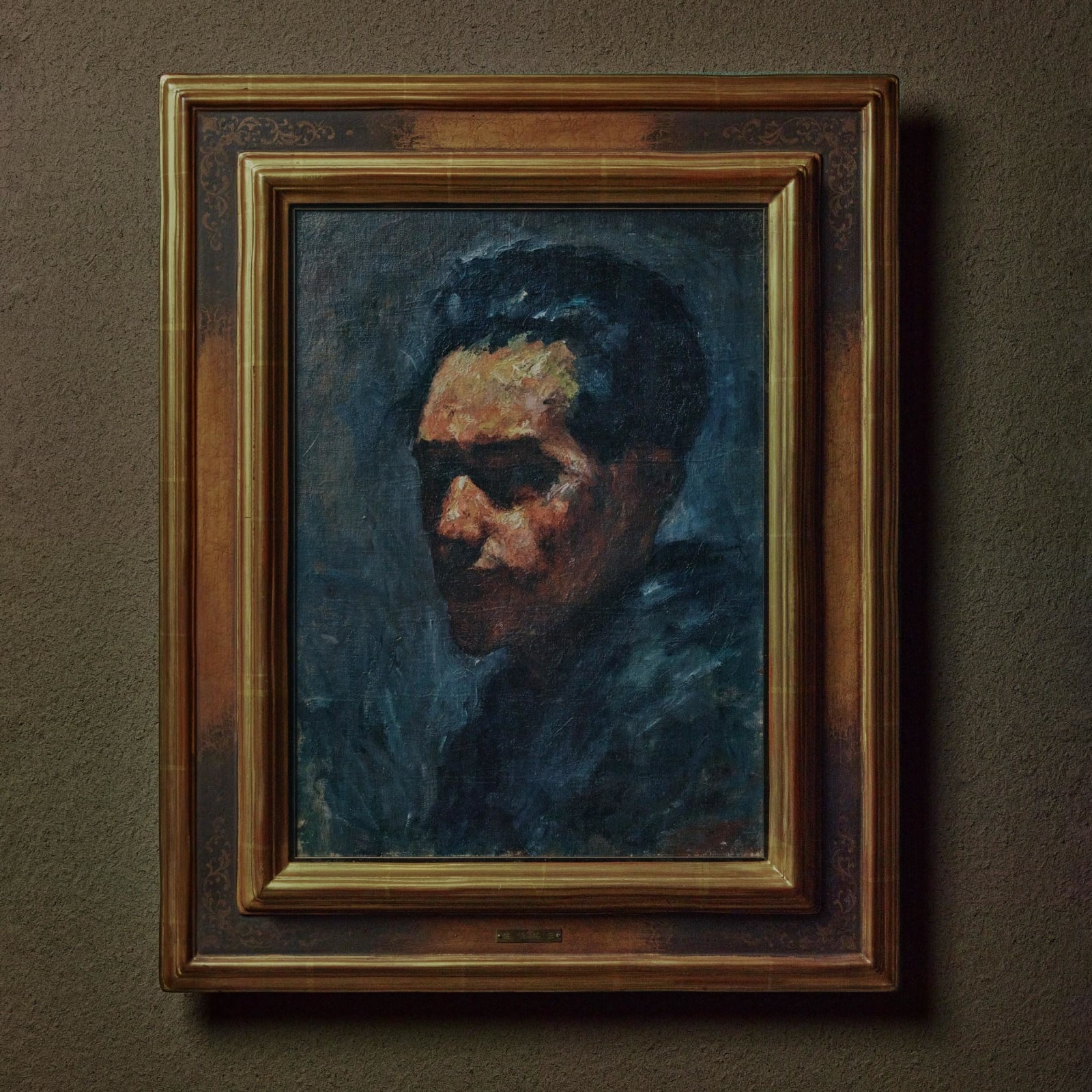Saeki Yūzō (1898–1928)
Self-Portrait
Oil on canvas, framed
46 x 34 cm
63 x 51 cm (overall)
46 x 34 cm
63 x 51 cm (overall)
Exhibitions
Saeki Yuzo ten. Takamatsu: Kagawaken bunka kaikan, 1973.Literature
Saeki Yuzo zengashu. Tokyo: Kodansha, 1968. Saeki Yuzo zengashu. Tokyo: Asahi Shimbunsha, 1979.
Over the course of his life, including the time before he enrolled at the Tokyo School of Fine Arts, Saeki Yuzo painted fourteen self-portraits in oil. If one includes works in watercolors and drawings, one arrives at a total of about twenty known self-portraits. The Nakanoshima Museum of Art, Osaka, which has opened this year, counts Standing Self-Portrait among the finest paintings of its Saeki Yuzo Collection. In the early summer of 1924, Saeki Yuzo and Satomi Katsuzo visited the Fauvist painter Maurice de Vlaminck in Auvers-sur-Oise. Saeki showed Vlaminck a nude he had painted after his arrival to France, but Vlaminck criticized it as “academic.” In Standing Self-Portrait, painted afterward, he used a different, rougher touch, even scratching off details of the face with a palette knife. This approach, especially with its treatment of the facial features, was a point of departure for Saeki. One might consider the fourteen self-portraits as forming something of a progression leading up to Standing Self-Portrait.
Let us consider Saeki Yuzo’s self-portraits. The earliest known Self-Portrait is signed on the front “June of Taisho 6 (1917), Saeki Yuzo,” now in the collection of the Kasama Nichido Museum of Art (Ibaraki Prefecture). Around the same year, Saeki painted Self-Portrait, now in the Aichi Prefectural Museum of Art, and another Self-Portrait which shows the artist in a frontal view. These three works of about 1917 present Saeki with a shaved head. This was followed by Self-Portrait with Hat from the collection of the Museum of Modern Art, Wakayama, in 1922. Self-Portrait in the collection of the National Museum of Modern Art, Tokyo, was painted either the same year as Self-Portrait with Hat or the year before. Then follows Self-Portrait in the collection of the Mie Prefectural Art Museum, dated 1922–1923, and Self-Portrait in the collection of the Kanagawa Prefectural Museum of Art, thought to be made in 1923. This raises the question when the present work was painted. Self-Portrait in the collection of the Tokyo University of the Arts is dated 1923 and Self-Portrait with Palette is dated 1924. Both works allow to trace the change of Saeki’s mustache style. Considering the combination of Saeki’s hair style, presence or absence of a mustache and the use of chiaroscuro for the details of the face, one must assume the present Self-Portrait dates around the time of 1922–23. Now what does that mean when seeing Saeki Yuzo’s works? One possibly has to start with comparing Self-Portrait to Standing Self-Portrait mentioned at the beginning.
Saeki Yuzo (yoga painter; 1898–1928)
Painter from Osaka. Saeki first studied at Akamatsu Rinsaku’s private art school; he later graduated from the Western-style painting department at the Tokyo School of Fine Arts. Together with Satomi Katsuzo, Saeki traveled to France and visited Maurice de Vlaminck, whose work proved to be of lasting influence to Saeki. Together with Satomi, Maeda Kanji, and others, he co-founded the 1930 Art Association. His works produced in Europe and his Shimo’ochiai series were well received. Saeki traveled once more to France, where he painted his masterpiece Postman, but died soon after from a combination of tuberculosis and nervous exhaustion.
Let us consider Saeki Yuzo’s self-portraits. The earliest known Self-Portrait is signed on the front “June of Taisho 6 (1917), Saeki Yuzo,” now in the collection of the Kasama Nichido Museum of Art (Ibaraki Prefecture). Around the same year, Saeki painted Self-Portrait, now in the Aichi Prefectural Museum of Art, and another Self-Portrait which shows the artist in a frontal view. These three works of about 1917 present Saeki with a shaved head. This was followed by Self-Portrait with Hat from the collection of the Museum of Modern Art, Wakayama, in 1922. Self-Portrait in the collection of the National Museum of Modern Art, Tokyo, was painted either the same year as Self-Portrait with Hat or the year before. Then follows Self-Portrait in the collection of the Mie Prefectural Art Museum, dated 1922–1923, and Self-Portrait in the collection of the Kanagawa Prefectural Museum of Art, thought to be made in 1923. This raises the question when the present work was painted. Self-Portrait in the collection of the Tokyo University of the Arts is dated 1923 and Self-Portrait with Palette is dated 1924. Both works allow to trace the change of Saeki’s mustache style. Considering the combination of Saeki’s hair style, presence or absence of a mustache and the use of chiaroscuro for the details of the face, one must assume the present Self-Portrait dates around the time of 1922–23. Now what does that mean when seeing Saeki Yuzo’s works? One possibly has to start with comparing Self-Portrait to Standing Self-Portrait mentioned at the beginning.
Saeki Yuzo (yoga painter; 1898–1928)
Painter from Osaka. Saeki first studied at Akamatsu Rinsaku’s private art school; he later graduated from the Western-style painting department at the Tokyo School of Fine Arts. Together with Satomi Katsuzo, Saeki traveled to France and visited Maurice de Vlaminck, whose work proved to be of lasting influence to Saeki. Together with Satomi, Maeda Kanji, and others, he co-founded the 1930 Art Association. His works produced in Europe and his Shimo’ochiai series were well received. Saeki traveled once more to France, where he painted his masterpiece Postman, but died soon after from a combination of tuberculosis and nervous exhaustion.



